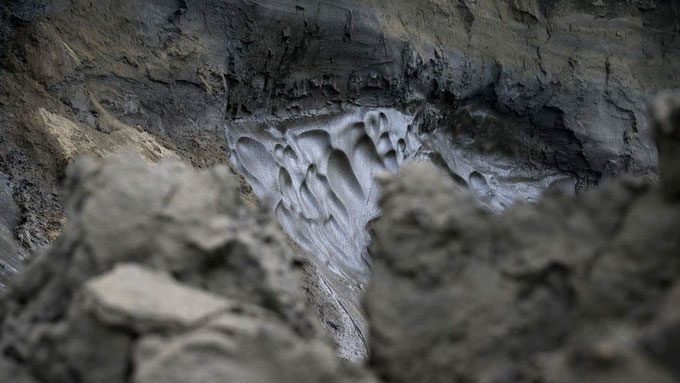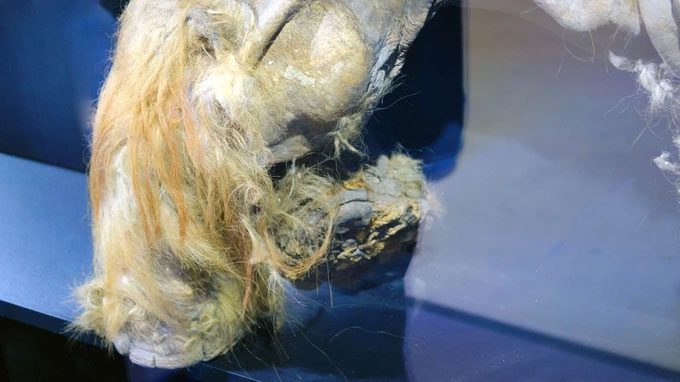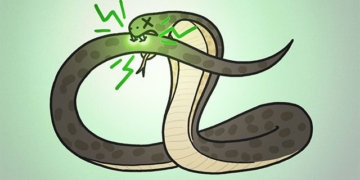The ice layers in the Arctic act as a “prison,” trapping ancient viruses and bacteria from prehistoric times, some of which pose a potential risk of disease transmission to humans.
Climate change has led to rising average temperatures worldwide, causing a significant amount of ice to melt and releasing bacteria and viruses from their frozen “prison,” where they have been trapped for millions of years.

Ancient ice in the Russian Far East is melting rapidly due to climate change, potentially releasing many unknown viruses to the world. (Photo: Live Science).
When these viruses are freed, they could carry pathogens unknown to science, posing risks of infection to humans or other animals.
Biologist Jean-Michel Claverie from Aix-Marseille University (France) warns: “The Earth is warming up, causing permafrost to continue melting rapidly. This will release viruses and bacteria that have existed for millions of years in ice, and they pose a risk of spreading pathogens that science has yet to discover.”
So far, scientists have only studied viruses in permafrost that infect single-celled organisms known as amoebas because they are harmless to humans and other animals.
Claverie explains: “We would never take the risk, and the world cannot afford to take risks when researching zombie viruses from modern mammals.”
To date, scientists have discovered more than 10 types of viruses in permafrost, hiding in samples ranging from woolly mammoth fur to the fossilized intestines of a Siberian wolf.
Here are some of the “zombie” viruses that science has uncovered from the Arctic:
Pithovirus sibericum is one of the largest viruses ever found, over 30,000 years old.
It measures about 1.5 micrometers, is oval-shaped with thick walls and an opening at one end, and has a bottle-like structure or net-like appearance.
In 2000, during efforts to hunt for unknown pathogens, this virus was discovered in samples of ancient permafrost in Siberia (in the Russian Far East).
Researchers named this virus after the Greek word “pithos”, which means a two-handled jar.
These objects were used by ancient Greeks to store wine and food.
Mollivirus sibericum was found frozen in the same 30,000-year-old permafrost sample in Siberia as the Pithovirus sibericum.
This virus is spherical, surrounded by a protective hairy coat, and can produce and release 200 to 300 new viruses from each amoeba it infects.
Although Mollivirus sibericum is not harmful to humans or other animals, the discovery of two ancient viruses in a single sample indicates that dormant pathogens may still lurk in permafrost.

Pithovirus mammoth virus found in a clump of woolly mammoth fur. (Photo: Live Science).
Pithovirus mammoth is the second strain of Pithovirus discovered from a clump of woolly mammoth fur, estimated to be over 27,000 years old, on the banks of the Yana River in the Russian Far East.
It measures 1.8 micrometers in length and has a bottle-like structure. Its only host is the amoeba.
Claverie and his colleagues described Pithovirus mammoth in a study published on February 14 in the journal Virus.
The study identified 13 types of “zombie” viruses revived from permafrost in Siberia.
Three of them include Pithovirus mammoth, Megavirus mammoth, and Pandoravirus mammoth, all discovered in the same prehistoric ice block containing woolly mammoth fur.
Pandoravirus yedoma is the oldest virus revived from permafrost to date, over 48,500 years old. It has a large egg-shaped nucleus and is 1 micrometer long.
Researchers discovered it in permafrost sediments beneath a lake in Yukechi Alas, in the Russian Far East.
This is one of the 13 types of “zombie” viruses reported in the aforementioned study.
Human abuse and overuse of fossil fuels (coal, oil) are accelerating global warming.
Climate change increasingly adversely affects the lives of humans and animals. Today, humanity is also facing new diseases from ancient viruses in the Arctic.



















































